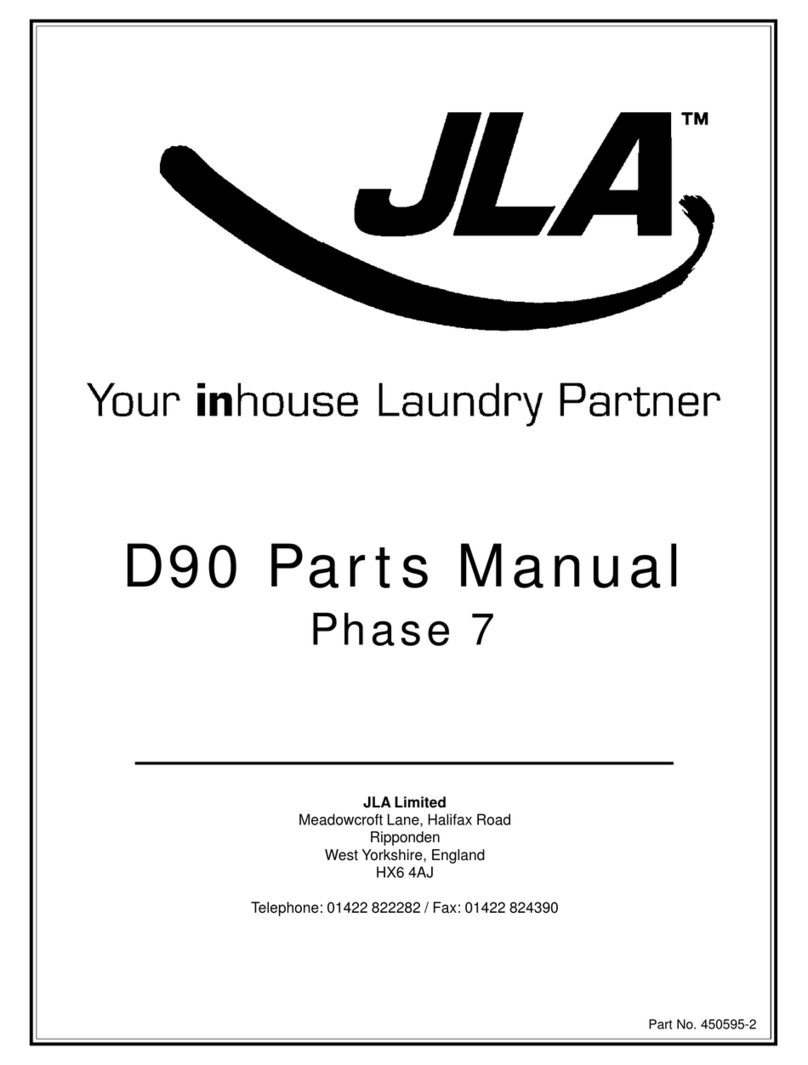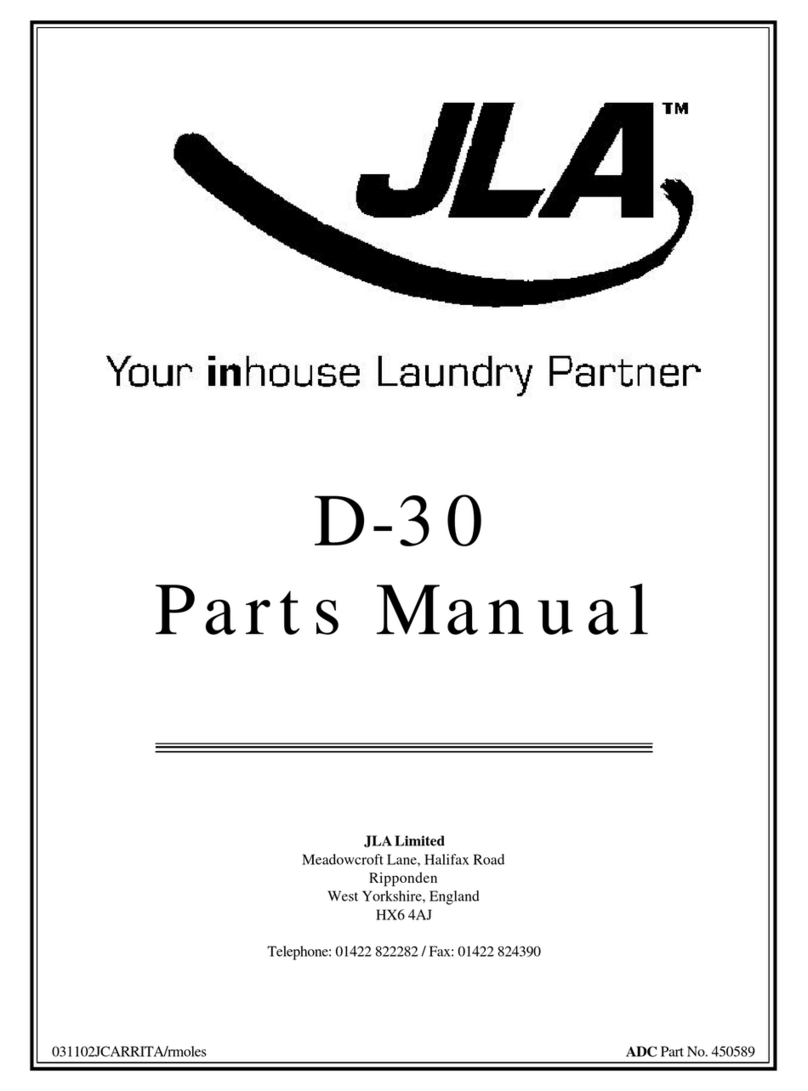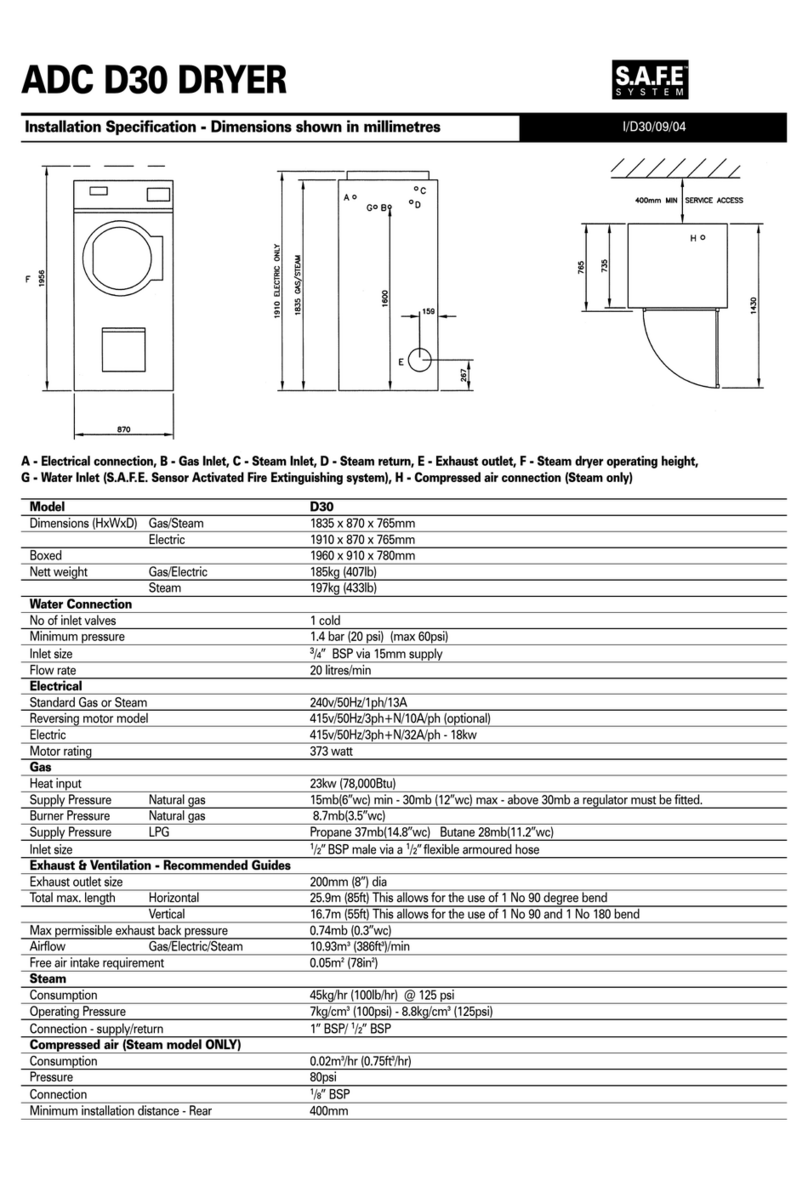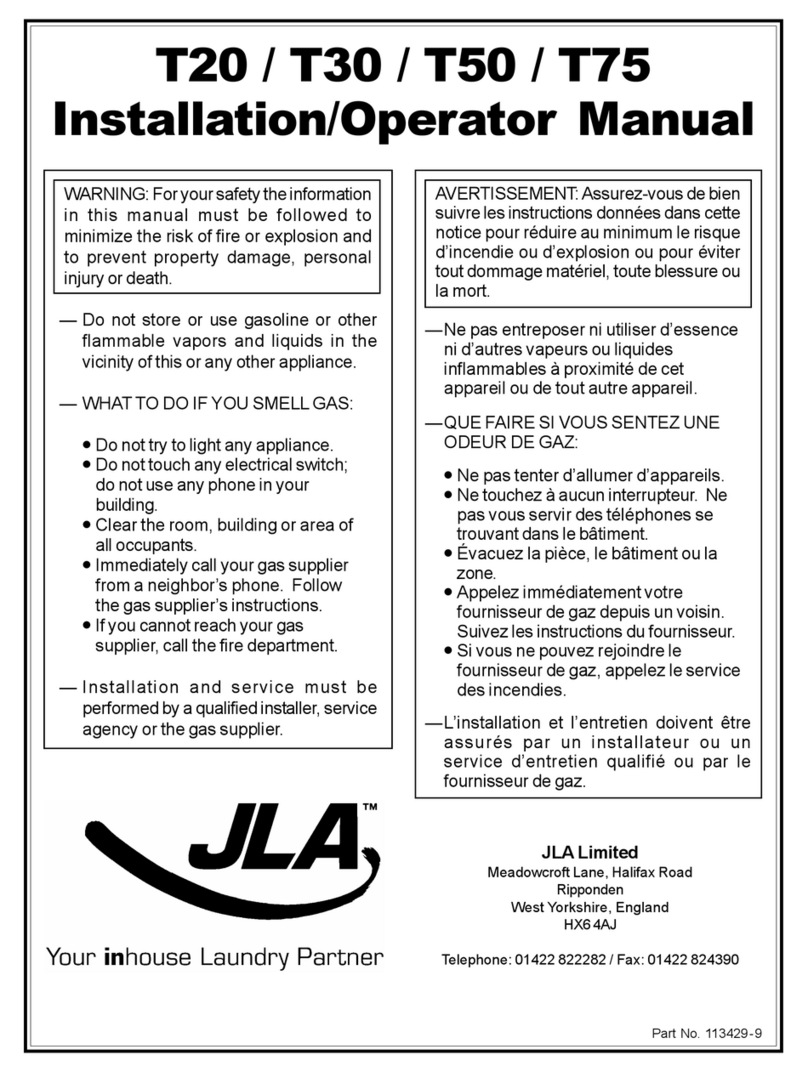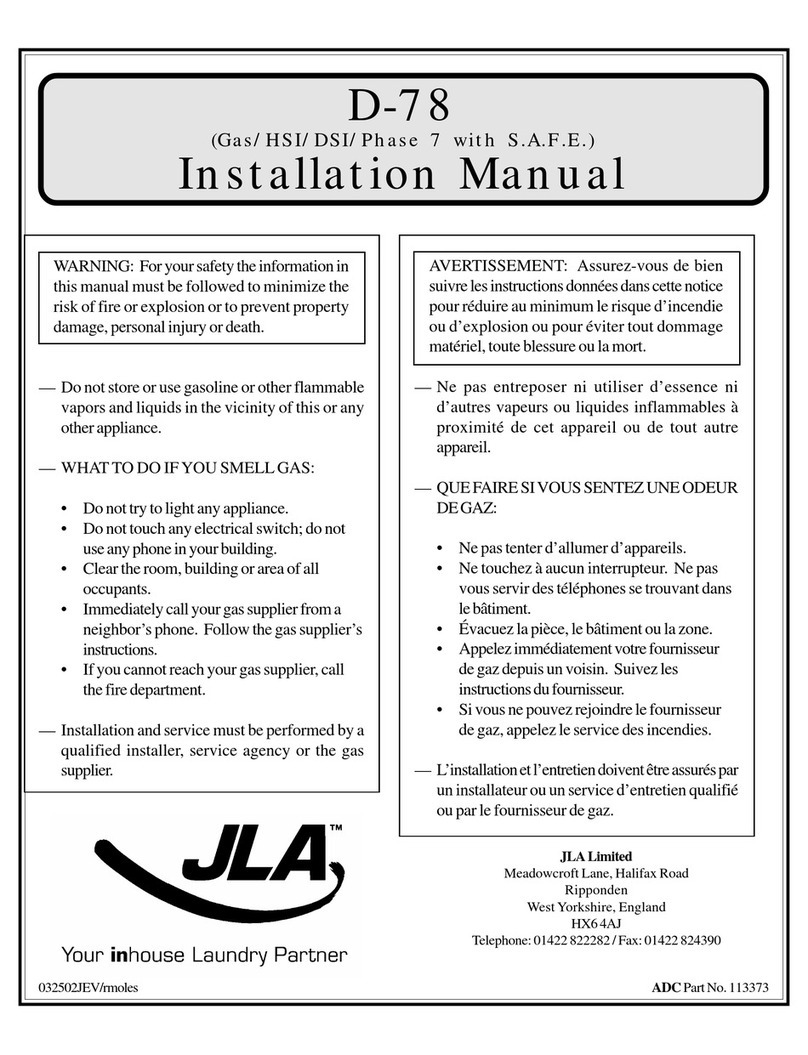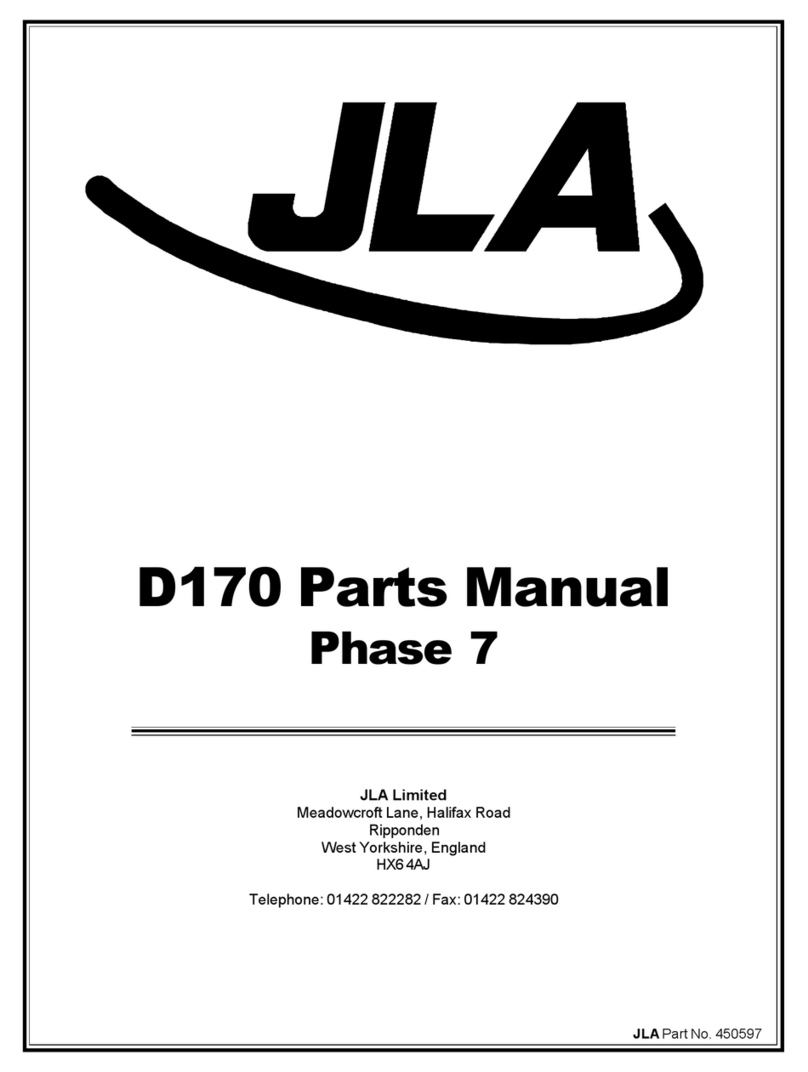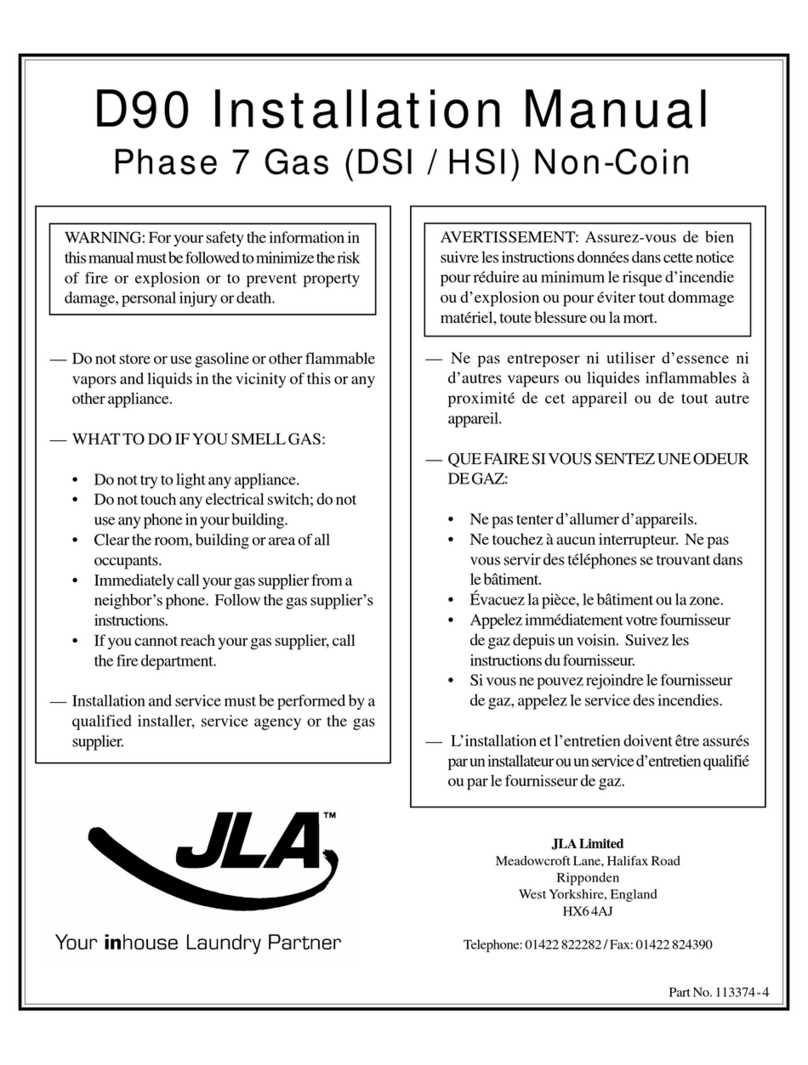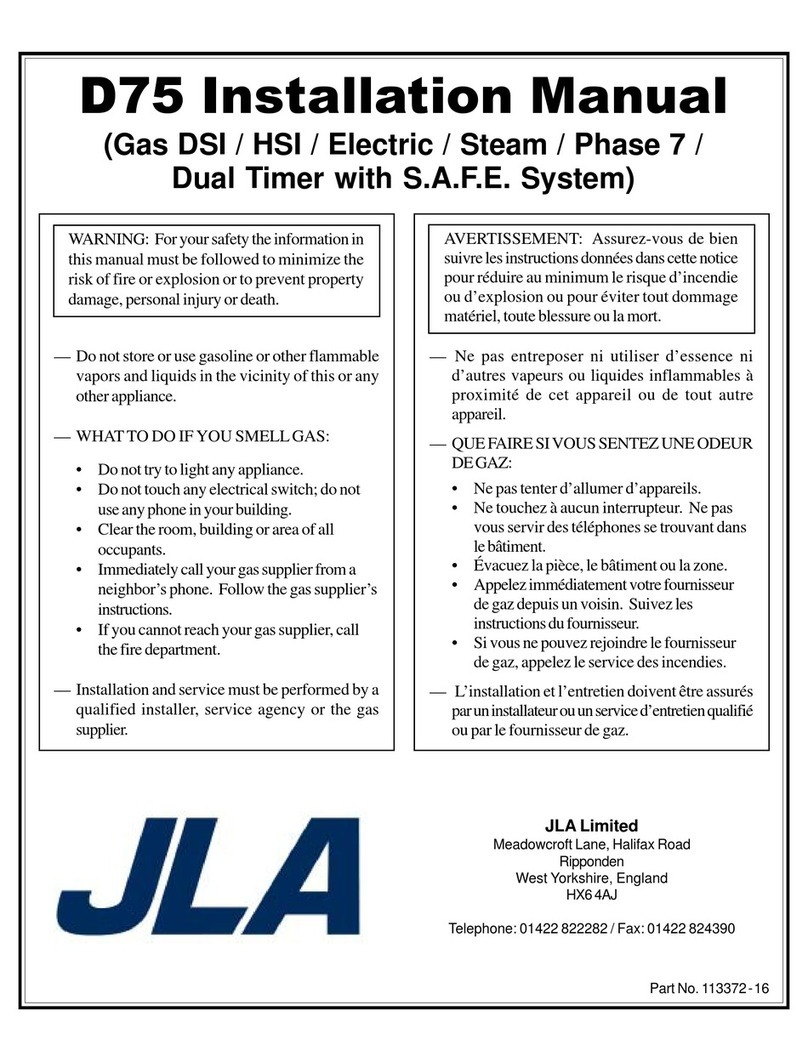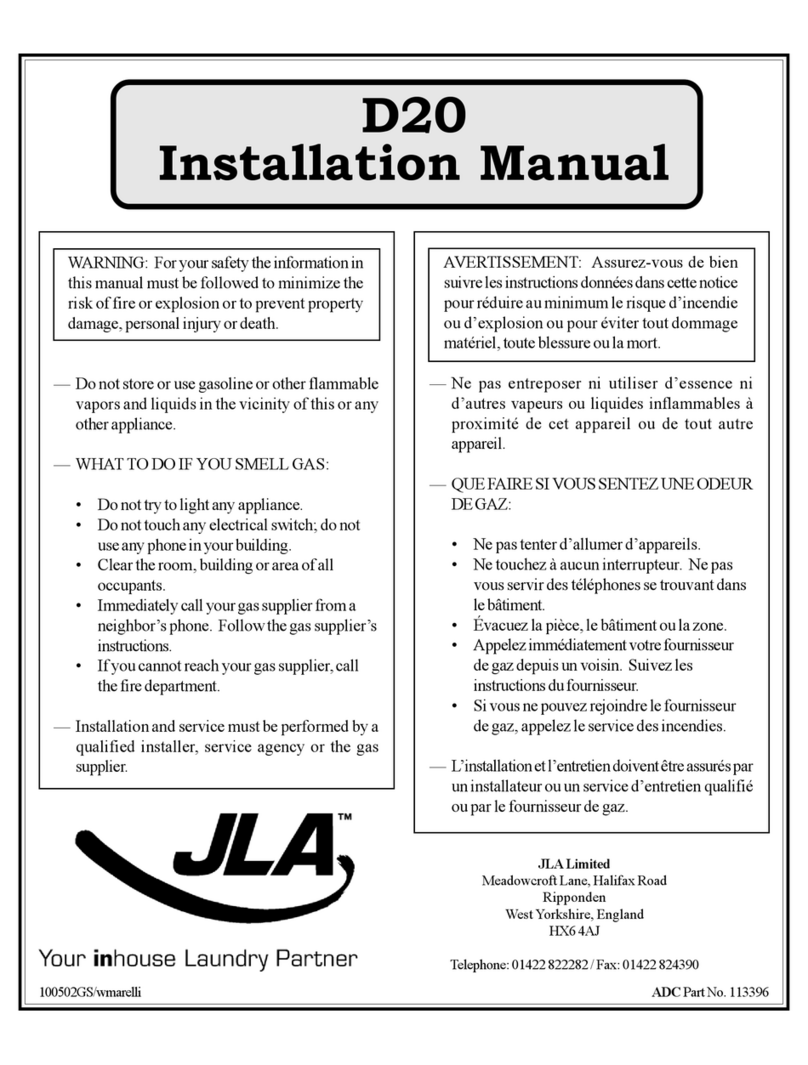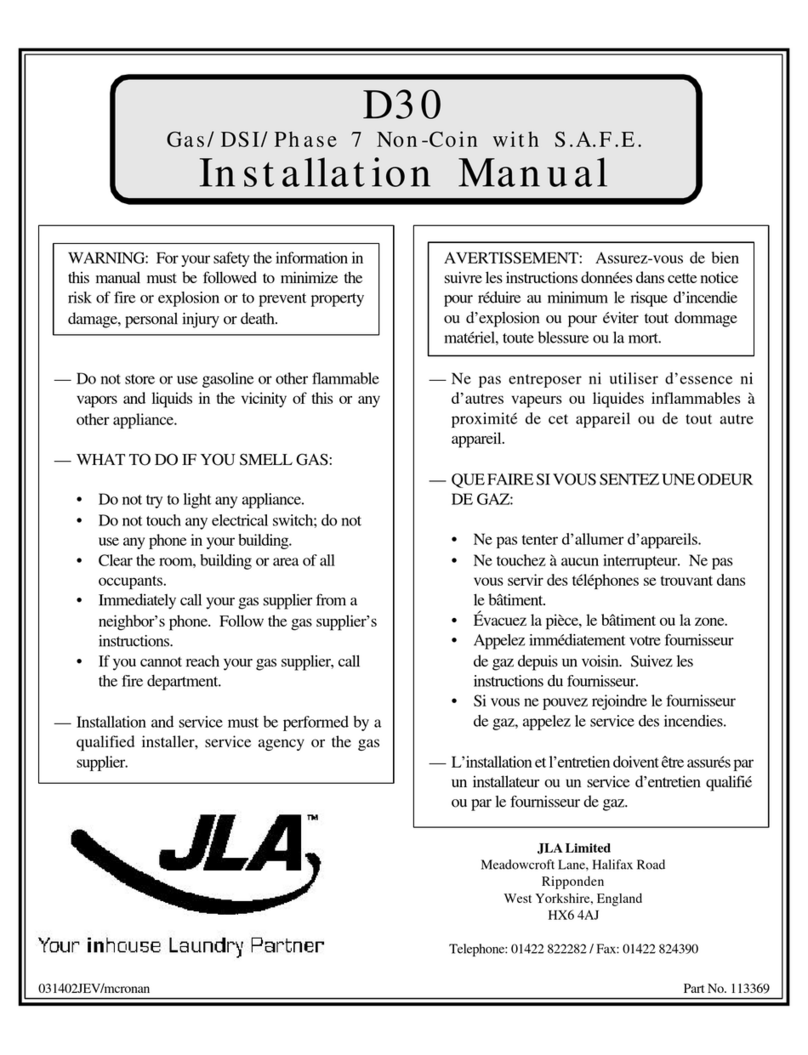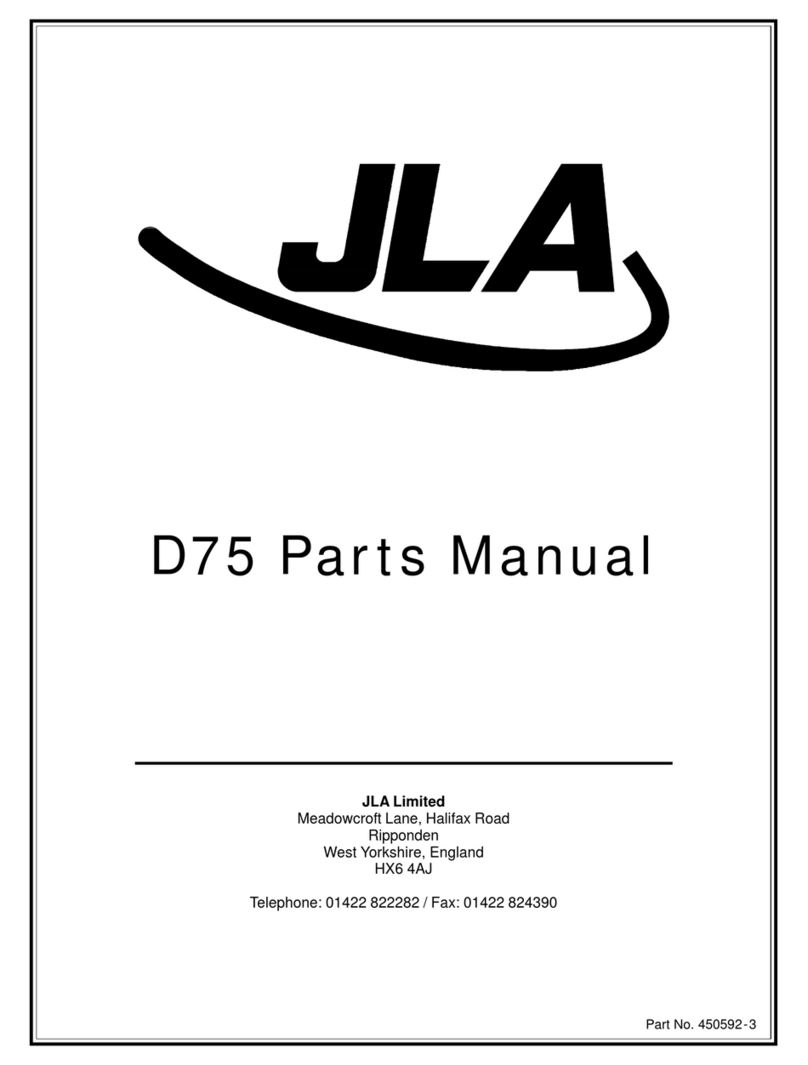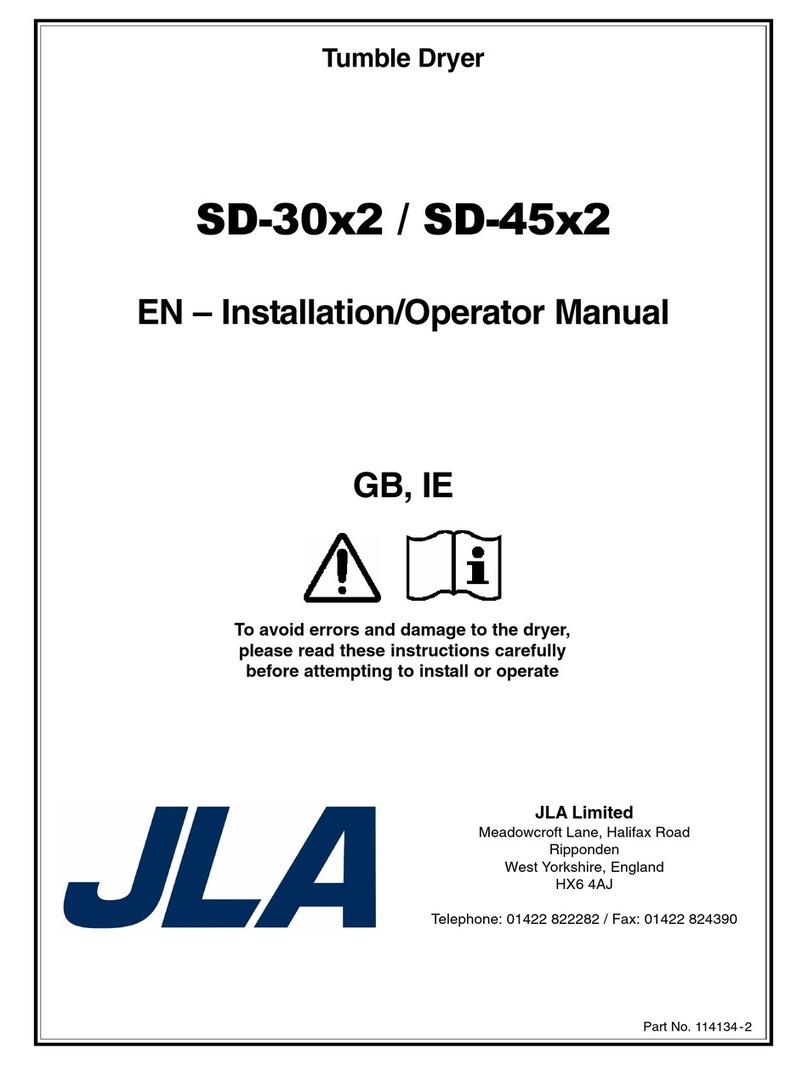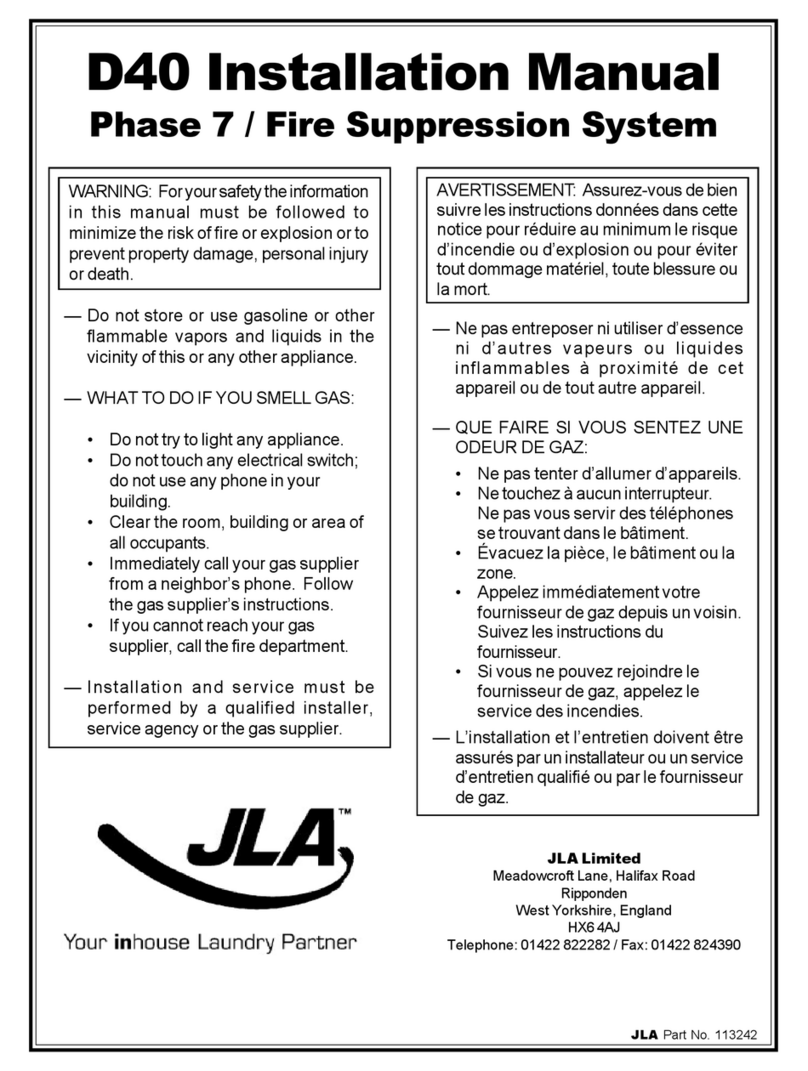
10 JLA Limited 113375-16
NOTE 1 Opening must be 2-inches (5.08 cm) larger than the duct (all the
way around). The duct must be centered within this opening.
NOTE 2 Distance should be 2 times the diameter of the duct to the nearest
obstruction.
Outside Ductwork Protection
To protect the outside end of the horizontal ductwork from
the weather, a 90° elbow bent downward should be installed
where the exhaust exits the building. If the ductwork travels
vertically up through the roof, it should be protected from
the weather by using a 180° turn to point the opening
downward. In either case, allow at least twice the diameter
of the duct between the duct opening and the nearest
obstruction.
IMPORTANT: Do not use screens, louvers, or caps on the
outside opening of the exhaust ductwork.
Single Dryer Venting
Where possible, it is suggested to provide a separate
exhaust duct for each dryer. The exhaust duct should be
laid out in such a way that the ductwork travels as directly
as possible to the outdoors with as few turns as possible. It
is suggested that the use of 90° turns in the ducting be
avoided; use 30° and/or 45° angles instead. The shape of
the exhaust ductwork is not critical so long as the minimum
cross section area is provided.
NOTE: It is recommended that exhaust or booster fans
not be used in the exhaust ductwork system except where
necessary to maintain exhaust back pressure (in the
exhaust duct) between zero and 0.3 inch water column.
Where employed, booster fans must not activate the dryer
airflow proving switch (sail switch) when the dryer is not in
operation.
When the exhaust ductwork passes through a wall,
ceiling, or roof made of combustible materials, the
opening must be 2-inches (5.08 cm) larger than the duct
(all the way around). The duct must be centered within
this opening.
As per the National Fuel Gas Code, “Exhaust ducts for
type 2 clothes dryers shall be constructed of sheet metal
or other noncombustible material. Such ducts shall be
equivalent in strength and corrosion resistance to ducts
made of galvanized sheet steel not less than 26 gauge
(0.0195-inches [0.50 mm]) thick.”
IMPORTANT: Make-up air must be provided from a
source free of dry cleaning solvent fumes. Make-up air
that is contaminated by dry cleaning solvent fumes will
result in irreparable damage to the motors and other dryer
components.
NOTE:
Component failure due to dry cleaning solvent
fumes will void the warranty.
Exhaust Requirements _______________
General Exhaust Ductwork Information
Exhaust ductwork should be designed and installed by a
qualified professional. Improperly sized ductwork will create
excessive back pressure which results in slow drying,
increased use of energy, overheating of the dryer, and shut
down of the burner by the airflow (sail) switches, burner
hi-limits, or tumbler hi-heat thermostats. The dryer must be
installed with a proper exhaust duct connection to the
outside.
The design of the flue system shall be such that any
condensate formed when operating the appliance from cold
shall either be retained and subsequently re-evaporated or
discharged.
CAUTION: This dryer produces combustible lint and
must be exhausted to the outdoors.
Improperly sized or installed exhaust ductwork can
create a potential fire hazard.
NOTE:
When dryers are exhausted into a multiple
(common) exhaust line, each dryer must be supplied with
a back draft damper.
The ductwork should be laid out in such a way that the
ductwork travels as directly as possible to the outdoors with
as few turns as possible. Single or independent dryer venting
is recommended.
When single dryer venting is used, the ductwork from the
dryer to the outside exhaust outlet should not exceed 20
feet (6.09 meters). In the case of multiple (common) dryer
venting, the distance from the last dryer to the outside
exhaust outlet should not exceed 20 feet (6.09 meters). The
shape of the ductwork is not so critical so long as the
minimum cross-sectional area is provided. It is suggested
that the use of 90° turns be avoided; use 30° and/or 45°
bends/angles instead. The radius of the elbows should
preferably be 1-1/2 times the diameter of the duct. Excluding
tumbler/dryer elbow connections or elbows used for outside
protection from the weather, no more than two elbows should
be used in the exhaust duct run. If more than two elbows
are used, the cross-sectional area of the ductwork must be
increased in proportion to the number of elbows used.
All ductwork should be smooth inside with no projections
from sheet metal screws or other obstructions, which will
collect lint. When adding ducts, the duct to be added should
overlap the duct to which it is to be connected. All ductwork
joints must be taped to prevent moisture and lint from
escaping into the building. Inspection doors should be
installed at strategic points in the exhaust ductwork for
periodic inspection and cleaning of lint from the ductwork.
IMPORTANT: Exhaust back pressure measured by a
manometer/magnehelic in the exhaust duct must be no
less than 0 and must not exceed 0.3 in WC (0.74 mb).






